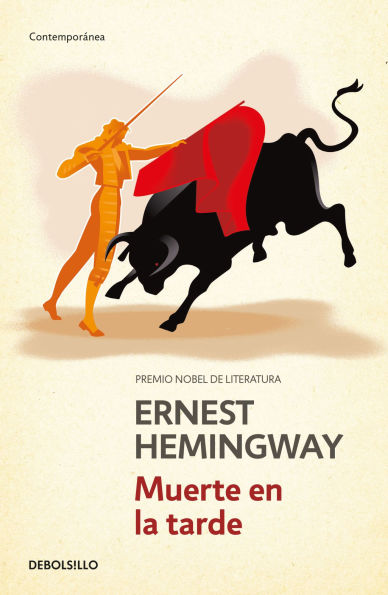Muerte en la tarde / Death in the Afternoon
Una obra que refleja la fascinación del Premio Nobel de Literatura por las corridas de toros y una profunda reflexión sobre el sentido trágico de la vida.
En 1927, Hemingway publicó Fiesta, iniciando así una serie de novelas-reportaje relacionadas con su fascinación por el mundo de los toros. A esta siguió Muerte en la tarde (1932) que es, además de una descripción técnica y minuciosa de una corrida vista desde los ojos de un profano, un ensayo profundo y sin concesiones sobre el arte del riesgo y la estrecha relación entre vida y crueldad con el que Hemingway regresa, una vez más, al tema que cohesiona su obra: el sentimiento trágico de la vida y el instinto de autodestrucción.
José Luis Castillo-Puche dijo...
«Solo su obsesión por la muerte nos explica su afición casi mística a lo taurino.»
ENGLISH DESCRIPTION
Ernest Hemingway's classic exploration of the history and pageantry of bullfighting, and the deeper themes of cowardice, bravery, sport and tragedy that it inspires.
Still considered one of the best books ever written about bullfighting, Death in the Afternoon reflects Hemingway's belief that bullfighting was more than mere sport. Here he describes and explains the technical aspects of this dangerous ritual, and "the emotional and spiritual intensity and pure classic beauty that can be produced by a man, an animal, and a piece of scarlet serge draped on a stick." Seen through his eyes, bullfighting becomes an art, a richly choreographed ballet, with performers who range from awkward amateurs to masters of great grace and cunning.
A fascinating look at the history and grandeur of bullfighting, Death in the Afternoon is also a deeper contemplation on the nature of cowardice and bravery, sport and tragedy, and is enlivened throughout by Hemingway's pungent commentary on life and literature.
1147271640
En 1927, Hemingway publicó Fiesta, iniciando así una serie de novelas-reportaje relacionadas con su fascinación por el mundo de los toros. A esta siguió Muerte en la tarde (1932) que es, además de una descripción técnica y minuciosa de una corrida vista desde los ojos de un profano, un ensayo profundo y sin concesiones sobre el arte del riesgo y la estrecha relación entre vida y crueldad con el que Hemingway regresa, una vez más, al tema que cohesiona su obra: el sentimiento trágico de la vida y el instinto de autodestrucción.
José Luis Castillo-Puche dijo...
«Solo su obsesión por la muerte nos explica su afición casi mística a lo taurino.»
ENGLISH DESCRIPTION
Ernest Hemingway's classic exploration of the history and pageantry of bullfighting, and the deeper themes of cowardice, bravery, sport and tragedy that it inspires.
Still considered one of the best books ever written about bullfighting, Death in the Afternoon reflects Hemingway's belief that bullfighting was more than mere sport. Here he describes and explains the technical aspects of this dangerous ritual, and "the emotional and spiritual intensity and pure classic beauty that can be produced by a man, an animal, and a piece of scarlet serge draped on a stick." Seen through his eyes, bullfighting becomes an art, a richly choreographed ballet, with performers who range from awkward amateurs to masters of great grace and cunning.
A fascinating look at the history and grandeur of bullfighting, Death in the Afternoon is also a deeper contemplation on the nature of cowardice and bravery, sport and tragedy, and is enlivened throughout by Hemingway's pungent commentary on life and literature.
Muerte en la tarde / Death in the Afternoon
Una obra que refleja la fascinación del Premio Nobel de Literatura por las corridas de toros y una profunda reflexión sobre el sentido trágico de la vida.
En 1927, Hemingway publicó Fiesta, iniciando así una serie de novelas-reportaje relacionadas con su fascinación por el mundo de los toros. A esta siguió Muerte en la tarde (1932) que es, además de una descripción técnica y minuciosa de una corrida vista desde los ojos de un profano, un ensayo profundo y sin concesiones sobre el arte del riesgo y la estrecha relación entre vida y crueldad con el que Hemingway regresa, una vez más, al tema que cohesiona su obra: el sentimiento trágico de la vida y el instinto de autodestrucción.
José Luis Castillo-Puche dijo...
«Solo su obsesión por la muerte nos explica su afición casi mística a lo taurino.»
ENGLISH DESCRIPTION
Ernest Hemingway's classic exploration of the history and pageantry of bullfighting, and the deeper themes of cowardice, bravery, sport and tragedy that it inspires.
Still considered one of the best books ever written about bullfighting, Death in the Afternoon reflects Hemingway's belief that bullfighting was more than mere sport. Here he describes and explains the technical aspects of this dangerous ritual, and "the emotional and spiritual intensity and pure classic beauty that can be produced by a man, an animal, and a piece of scarlet serge draped on a stick." Seen through his eyes, bullfighting becomes an art, a richly choreographed ballet, with performers who range from awkward amateurs to masters of great grace and cunning.
A fascinating look at the history and grandeur of bullfighting, Death in the Afternoon is also a deeper contemplation on the nature of cowardice and bravery, sport and tragedy, and is enlivened throughout by Hemingway's pungent commentary on life and literature.
En 1927, Hemingway publicó Fiesta, iniciando así una serie de novelas-reportaje relacionadas con su fascinación por el mundo de los toros. A esta siguió Muerte en la tarde (1932) que es, además de una descripción técnica y minuciosa de una corrida vista desde los ojos de un profano, un ensayo profundo y sin concesiones sobre el arte del riesgo y la estrecha relación entre vida y crueldad con el que Hemingway regresa, una vez más, al tema que cohesiona su obra: el sentimiento trágico de la vida y el instinto de autodestrucción.
José Luis Castillo-Puche dijo...
«Solo su obsesión por la muerte nos explica su afición casi mística a lo taurino.»
ENGLISH DESCRIPTION
Ernest Hemingway's classic exploration of the history and pageantry of bullfighting, and the deeper themes of cowardice, bravery, sport and tragedy that it inspires.
Still considered one of the best books ever written about bullfighting, Death in the Afternoon reflects Hemingway's belief that bullfighting was more than mere sport. Here he describes and explains the technical aspects of this dangerous ritual, and "the emotional and spiritual intensity and pure classic beauty that can be produced by a man, an animal, and a piece of scarlet serge draped on a stick." Seen through his eyes, bullfighting becomes an art, a richly choreographed ballet, with performers who range from awkward amateurs to masters of great grace and cunning.
A fascinating look at the history and grandeur of bullfighting, Death in the Afternoon is also a deeper contemplation on the nature of cowardice and bravery, sport and tragedy, and is enlivened throughout by Hemingway's pungent commentary on life and literature.
16.95
Pre Order
5
1

Muerte en la tarde / Death in the Afternoon
328
Muerte en la tarde / Death in the Afternoon
328Paperback
$16.95
16.95
Pre Order

Product Details
| ISBN-13: | 9786287745667 |
|---|---|
| Publisher: | PRH Grupo Editorial |
| Publication date: | 09/23/2025 |
| Pages: | 328 |
| Product dimensions: | 4.89(w) x 7.47(h) x 0.71(d) |
| Language: | Spanish |
About the Author
From the B&N Reads Blog
